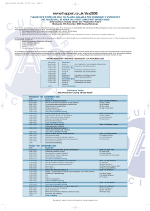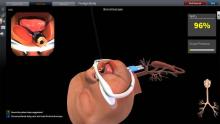DAS 2008 LIVERPOOL MEETING

2008 was the year in which Liverpool was Europe's "Capitol of Culture" and the DAS Meeting to coincide with this was held in Liverpool's famous (or perhaps infamous?) Britannia Adelphi Hotel. Workshops were held on Wednesday 12th November and the Scientific Meeting on 13th and 14th.
Thanks to Peter Charters, Peter Groom, Seema Darshane, Mohidin Ali, Rajagopal Vennila and Denise Morgan O'Neil for all their work organizing such a highly successful meeting.
The DAS organisers for this year's meeting once again impressed with their choice of venue; a grand Victorian hotel with an interior reminiscent of the transatlantic liners of yore. The Hotel was large enough to accommodate the majority of delegates, the workshops and two lecture theatres while simultaneously playing host to the 2008 World Amateur Boxing Championships. (The latter inspired many interesting conversations and photo opportunities, to say nothing of multitude of extreme physical activities evident on the landings and corridors!)
WORKSHOPS
The first day's workshops proved particularly popular. The workshop differed from previous years in that it was based on the Aintree Difficult Airway Management (ADAM) concept. The day combined a pre-course manual with lectures, traditional and multimedia workstations to provide a detailed grounding for delegates in the management of the anticipated difficult airway. The organisers are to be congratulated for amassing such a lot of equipment and a hugely experienced faculty enabling a faculty: delegate ratio of 1:4 for the 128 delegates. As well as standard teaching the day included simulations of difficult airway cases that highlighted the ADAM approach and website. Feedback revealed 96% felt the course changed their practice with 92% saying they would recommend it to others.

ANNUAL SCIENTIFIC MEETING
The main meeting began with a welcome and introduction from Dr Peter Charters who, with the help of his local committee, had done such a fantastic job in organising the event. He explained why, for the first time, the conference had a unifying theme; "Why Mechanisms Causing Difficulty Matter" and an unashamedly local flavour reflecting the huge contribution to airway management made by clinicians from Merseyside. The academic credentials of the meeting were highlighted by the presence of five Professors of Anaesthesia and one Reader in Surgery. For the untamed youthful enthusiasts there would be a targeted session entitled "Got my 'big idea' but what next?" Dr Charters then introduced, as a DAS first, an Audience Response System, (as in "Who wants to be a millionaire?") which itself went on to have the best feedback response of any previous DAS meeting.
The first session, Chaired by Dr. Ellen O'Sullivan, dealt with airway assessment issues. Dr. Charters presented the anatomical mechanisms inherent to the difficult airway and in the process succeeded in destroying the 'anterior larynx' shibboleth. Dr Ian Tweedie proposed that airway assessments should be conducted along the lines of a problem list tailored to the patient's medical condition / anatomy. The next two speakers were very entertaining. Mr. Terry Jones, consultant ENT surgeon, extolled the value of nasal endoscopy in preoperative assessment and demonstrated its ease of use on his research registrar to the delight and amazement of the audience. The final speaker of this session, Dr Hugh Lewis-Jones, romped through the importance of airway imaging whist aiming his presentation toward the "green wing".
The day's second session was chaired by Dr. Tim Cook and highlighted the importance of planning for the worst-case scenario in airway management. Dr Mark Halligan persuaded us of the value of tailoring airway management devices to deal with specific problems; stressing the advantages and disadvantages of different devices dealing with common problems such as tumours and abscesses. Dr Seema Darshane continued this theme in her fascinating talk about how manikin studies explain the 'pear drop effect' hypothesis; her videos clearly showing how the effect is produced with a Macintosh laryngoscope. Dr Peter Groom brought all the mornings theme's together in his presentation entitled Responsive Contingency Planning. This was an overview of the ADAM approach stressing the value of a detailed anaesthetic plan encompassing the patient assessment, choice of airway management technique to deal with the individual patient's problems and an appreciation of how and why the plan may fail in practice prior to embarking on intubation.
Following lunch, Professor Martin Leuwer chaired the poster presentation session with prizes awarded the following day. Whilst across the foyer the conference's first breakout session took place in the form of a popular Industry presentation. (Industry was especially complimentary about this innovation and the space and facilities of the exhibition hall.)
The Final session of the day, chaired by Professor Jennifer Hunter, concerned why, despite our best intentions, intubation plans fail. Dr Venilla's talk highlighted the multi-factorial reasons that constitute a difficult intubation. (This talk also proved to be the most appreciated application of the ARS as far as audience engagement was concerned because of the chance to compare managements of the case presentations!) Dr Dermot Moloney developed the theme by showing that contingency planning reduces failure by highlighting in advance where plans can go wrong and fostering a team approach (anaesthetist, ODA and surgeon) to finding solutions and seeking expert assistance in advance as necessary. Dr Raj Nagaraja finished the day discussing an ITU perspective of the postoperative management of a difficult / failed intubation.
After the last session we adjourned to a smaller conference room for the society's annual general meeting. Following this came a fantastic Gala dinner during which the "Singing Waiters" proved an unexpected cultural extravaganza when they broke into song to the wonderment of all concerned. In true DAS tradition, the party continued until the small hours of the morning.
The second day got off to a cracking start with a Paediatric and Obstetric session chaired by Dr. Chris Frerk. First speaker was Dr. Frank Potter who described the multi-factorial nature of neonatal and childhood airway problems in both acute and elective practice experienced in Alder Hey hospital. Dr Eddie Djabatey then showed how an enlightened approach to Obstetric Anaesthesia in the Liverpool Women's Hospital had resulted in zero failed intubations over an 8 year period. The session finished with a fascinating lecture of the value of human factors and the "no-tech" approach to airway management by Dr. Ravi Dravid and Mr. Trevor Dale.
After coffee there were two parallel sessions. One concerned the practicalities of taking ones idea and inspiration for novel airway devices from a pipe dream through to the ultimate step of marketing. The session was chaired by Dr. Charters and covered publication issues (Professor Judith Hall), intellectual property matters (Mr. Mark Earnshaw) and then two fascinating success stories about 'How I did it' featuring Dr. Muhmammed Nasir and Dr. Pedro Acha. The latter recounted their experiences developing and marketing the I-Gel and Airtraq respectively. The alternative breakout session chaired by Dr. Anil Patel, was a debate on whether "Sugammadex will improve safe management of the difficult airway". Professor Hunter reviewed the pharmacology before Professor Rajinder Mirakur (Liverpool's "other" Honorary Professor) argued in favour and Dr. Cook against the motion. After a lighthearted and enthusiastic debate the motion was defeated.
After lunch Dr Barry McGuire gave a very professional advertisement for the next year's conference in Perth. This was followed by Dr Dravid overseeing the prize giving and an update of current DAS projects and initiatives. Dr. Nick Woodall whetted our appetite for the forthcoming NAP4 audit in a wide-ranging lecture.
The last session of the conference was possibly the most valuable as it concerned itself with the often poorly understood and managed topic of airway trauma. Mr. Patrick Magennis enhanced his reputation as a comedian not to mention Consultant Maxillofacial surgeon in his talk on facial trauma and its relevance to UK urban life. Mr. Nick Roland, Consultant ENT surgeon gave a brilliant overview of the aetiology and presentation of upper airway trauma. Finally Dr Richard Craig emphasised the pitfalls inherent in the airway management of blunt and penetrating airway trauma.
The meeting concluded in high spirits as delegates made their way off into the early evening gloom towards Lime Street station or the M62 with the intention of all meeting again in a year's time north of the border.
DAS 2008 LIVERPOOL TIMETABLE

